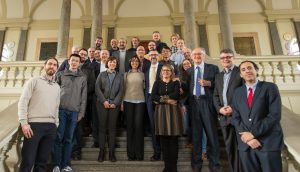 PASSION project partners at kick-off meeting at Politecnico di Milano on 12 December 2017.
PASSION project partners at kick-off meeting at Politecnico di Milano on 12 December 2017.
Over recent decades, the optical communications sector has enabled and assisted in the continuous development of the fibre-based networks for metropolitan applications, but the industry is now facing a bottleneck in the transmission and the routing of the huge amount of data due to the dramatic increase in the users number, in the content size, and to the convergence of mobile and datacom networks.
Photonics is a key enabling technology for the evolution of the entire telecommunications infrastructure, but the technologies used so far for the metro network directly derive from the long-distance transport and they are too expensive and power hungry.
New optical platform
PASSION is a new platform based on photonic technologies supporting the development of the future metropolitan communications network, characterised by very high transmission capacity, low cost and reduced energy consumption. Innovative transmission, detection and routing solutions and a new network architecture to ensure a transmission rate of over 100 Tb/s per link and a switching capacity of over 1 Pb/s per node.
PASSION will develop an innovative technological platform based on directly-modulated vertically emitting laser sources (VCSEL) and on multi-channel coherent receivers integrated on Silicon-Photonics technology, providing high modularity and aggregating signal flows with a capacity of 16 Tb/s per channel and 112 Tb/s per link exploiting a 7-core fibre.
PASSION technologies will achieve a 10-fold power-consumption reduction with respected to commercially available modules based on externally modulated traditional sources. The dimensions of the PASSION modules will be even 3 orders lower than the current WDM solutions.
Flexible network architecture
Thanks to these innovative transmitters and receivers PASSION will design a flexible network architecture, optimised for metro applications, based on aggregated signal flows, exploiting the full wavelength spectrum and the “space” dimension in a multi-core fibre.
Photonic devices capable of aggregating/disaggregating and/or routing data flows in spectrum and/or in space will allow a switching capacity of 1 Pb/s node. The metro network architecture developed in PASSION will thus provide a full programmability to match the traffic evolution and the increasing communications needs of our society.
Pierpaolo Boffi, professor at the Politecnico di Milano and coordinator of PASSION, commented, “The PASSION project is adopting a disruptive approach in the design of components and devices as well as in the network architecture and management with respect to today’s metro network solutions.
“PASSION’s ambitious goal is to provide a sustainable communications infrastructure in terms of cost and energy consumption, ensuring the effective transmission and routing of a huge amount of data in our cities. PASSION will strengthen the European industrial leadership in optical communications and it will support a highly connected and communicating society with important social and economic benefits.”



